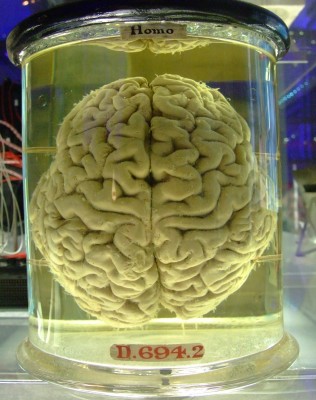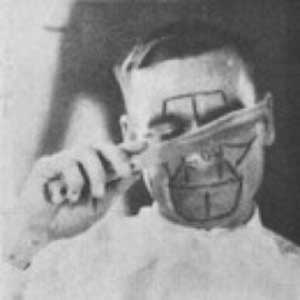Science is wonderfully equipped to answer the question “How?” but it gets terribly confused when you ask the question “Why?” (Erwin Chargaff, biochemist)
We all know that scientific experiments are meant to be conducted in a way so that they provide some sort of useful information. Whether it be an experiment to test a cure for a disease, or just to observe something naturally, most experiments are seen as beneficial as they provide new information to questions scientists have today. However, scientific experiments can be confusing and difficult to understand, and at times some would agree that they’re not always helpful or even useful.
Below are ten scientific experiments that really make you wonder, “Why?” Though they may have provided some sort of new information to the experimenters, the experiments all together really seem bizarre.
Note from Toptenz: In some cases where the photos were too disturbing, we have not included the genuine photos/film footage from these experiments.
10. Keeping a Dog’s Head Alive

You probably know all about the popular use of the guillotine during the French Revolution, which severed many heads. You may have even heard the numerous accounts of people seeing heads’ eyes blink after being severed. With these observations, many started to wonder if it was possible to keep a severed head alive. Soon enough, Sergey Brukhonenko, a Soviet physician in the 1920s decided to test this theory. Since using a human head would seem a little crazy, Brukhonenko decided to use a dog’s head, which he was able to successfully keep alive with the use of a machine he made known as an “autojector.” The machine acted like the dog’s heart and lungs, and to prove that the dog was still alive, Brukhonenko would shine a light in its eyes and it would blink. He’d also slam a heavy object on the table and the dog would flinch, and he even went as far to feed the dog food, which just fell out of its throat. By responding to stimuli, it was obvious that the dog’s head was in fact alive.
What’d We Learn
From these experiments, the first successful heart-lung machines were later created. We’ve also learned that if you do some whacky experiments, you become the talk of the town, or in Brukhonenko’s case, the talk of all of Europe. George Bernard Shaw poked fun at the experiments, stating that he’d love to be Brukhonenko’s muse and live with his head cut off so that he could continue to write literature and plays.
9. Turned-On Turkeys
Of course humans aren’t the only ones with a libido; turkeys join in on the fun as well. During the 1960’s, Martin Schein and Edgar Hale became oddly curious about the stimuli needed to “excite” a turkey, as they observed turkeys attempting to mate with a fake female turkey. To start their experiment, the two created a life-like female turkey that would attract a male. They then would remove a part of the turkey, such as the wings, tail, and feet, to see if the turkey was still interested. By the end of it all, the only thing left of the turkey was a head on a stick, and somehow the turkey was still interested, and attempted to mate with it. To go even further, the two tested out their findings on whether the turkey preferred a real turkey head or a wooden one. In the end, the turkey seemed content with both, but the real turkey head was most preferred.
What’d We Learn
We’ve realized that turkeys are highly loving creatures who do not discriminate and will always take what they are given. We’ve also learned that seemingly all male creatures aren’t very picky at all and will take what they can get. In short, this experiment didn’t provide very much to the scientific world.
8. Cerberus Minus 1

In the 1950’s, Vladimir Demikhov was determined to make some sort of new break when it came to organ transplants. To further his studies and knowledge about the subject, he decided to create a two-headed dog, which could only be done by attaching the front end of a puppy to the neck of an older German Shepherd by grafting its shoulders and head. The puppy’s two front paws were often placed on each side of the other dog’s neck and was able to live, but not for long, often because the tissue was rejected. Demikhov not only made one two-headed dog, but 20 of them, most of which died within a few weeks, the longest living about a month.
What’d We Learn
It’s said that Demikhov’s experiment with making two-headed dogs lead to advances in heart and lung transplants in humans and also encouraged other doctors to perform similar experiments, such as Dr. Robert White’s two headed-monkey. While Demikhov’s aimed to become the first to do a successful organ transplant, Dr. Christian Barnard perfected the transplant before he died.
7. Life Through A Cat’s Eyes
Dr. Yang Dan, a professional of neurobiologist, decided that it’d be interesting to tap into another animal’s brain in order to see exactly what it is seeing. To do so, Dr. Dan anesthetized and chemically paralyzed a cat and then secured it into a surgical frame to start his experiment in the late 1990’s. In order for him to see what the cat was seeing, Dr. Dan glued metal posts to the whites of the cat’s eyes and then positioned its head so that it would be looking at a screen playing a movie with moving trees and men in turtlenecks. Fiber electrodes were then put into the cat’s brain, specifically the portion that is known to control vision and vision processing. The electrodes were connected to a computer which was able to record and transmit the information, and then put it into an image. As the movie played, images of the movie were portrayed on the computer screen, just a lot blurrier.
What’d We Learn
Someone was almost able to hit the nail on the head when it comes to aversion therapy described in the movie A Clockwork Orange. If you ever wanted to see what another creature was seeing, just consult this experiment and you just might be able to do it.
6. Setting a Homosexual Man Straight

After looking at research done by James Olds and Peter Milner regarding the septal regions of the brain, Robert Heath decided to take the information from the previous experiment and conduct his own by adding his own twist. Olds and Milner discovered that sensations of sexual arousal and pleasure are produced when the septal region of the brain is stimulated. During the 1950’s, Heath decided to try the experiment on men, instead of rats- but most importantly homosexual men. Heath aimed to test to see if he could stimulate these areas of the brain in order to turn a gay man straight. He placed electrodes into the septal region of the homosexual male’s brain and controlled the amount of applied stimulation. He then created a device that allowed the subject to “pleasure” himself, which was known as the “pleasure button.” In one session lasting three hours, the subject pressed the button 1500 times. With his libido skyrocketing, the subject was then introduced to a female prostitute. At first nothing happened, but when the prostitute offered to engage in sexual activity, the subject agreed. Not much is known of the subject after the experiments, except he became active in homosexual prostitution, but also possibly had an affair with a married woman.
What’d We Learn
A little pleasure goes a long way in this experiment. In the end, while the experiment may have been seen as a success, Heath wasn’t fully able to convert the homosexual subject into a heterosexual. I’m not sure the experiment provided a lot of new information to scientists.
5. What Face Would You Make While Decapitating a Rat?

We all know about facial expressions. A smile usually means one is happy, a frown indicates one is sad, and so on. However, in 1924, Carney Landis wanted to test the theory and find out if there is one special expression that is universal to everyone that is made when one experiences shock or disgust. Because he was fresh out of college with a psychology degree, Landis’ subjects for his experiment were fellow college students that he had known. In order to get accurate readings of the facial expressions, Landis used paint on his subject’s faces. The experiment started off normal; he’d have subjects smell ammonia, put their hand into a bucket of frogs with slime, or flash pornographic pictures at them. While this type of stimuli seems normal for an experiment about shock and disgust, this wasn’t the end of it. To conclude his experiment, Landis would hand his subject a knife and a live rat, and tell them to decapitate it. If the subject refused, Landis would decapitate the rat himself.
What’d We Learn
From his studies, Landis noted that his subjects, when in a hurry or feeling some sort of distress, did a “clumsy” job at decapitating the rat. However, Landis was never able to successfully match a facial expression to an emotion, therefore making his experiment not so successful. However, many look at his experiment and think of Stanley Milgram, as it is very shocking to see how his subjects, at least some of them, were willing to follow out such an absurd act, showing some sort of obedience.
4. Electrifying a Human Corpse
As if keeping a head alive wasn’t enough, Aldini Galvini decided to attempt to shock life into a human corpse after he realized that electricity, in high enough volts, was able to cause a dead corpse’s limbs to twitch (thanks to his uncle Luigi Galvini’s studies). Animals weren’t good enough for this experiment, so on January 17, 1803 George Forster was the victim, a recently executed murderer. To begin, the body was laid out and wires were placed on various places of the body, all which transmitted 120-volts of electricity. By placing the wires on the mouth and ears, Galvini noted that the jaw muscles moved and his entire face seemed to be in pain. His left eye is also said to have opened. As if the experiment couldn’t get any worse, Galvini decided to wrap it up by putting a wire on the ear and sticking the other in Forster’s rectum. According to those watching, his body “was on the eve of being restored to life.”
What’d We Learn
While we don’t exactly know how to bring a dead corpse back to live, we did learn that a high amount of voltage introduced to the body will make it move, more so jerk. While the experiment wasn’t the most enlightening, both Mary Shelley and Edgar Allan Poe used the experiment ideas as inspiration for writing.
3. A Remote-Controlled Bull
We’ve heard of a remote-controlled car, and maybe even a remote-controlled airplane, but a remote-controlled bull? While it seems completely impossible, Jose Delgado was able to entirely control a bull with the press of a button in 1963. In order to control the bull’s actions, a chip, known as a stimpceiver, was implanted into his brain and was controlled by the remote Delgado held. The remote was able to electrically stimulate different parts of the brain, which control different actions and behaviors. To prove it a success, Delgado stood in a typical bull-fighting ring, and once the bull saw him, it began to charge, but with the press of the button, the bull immediately became uninterested and just walked away. Because of his experiment, scientists all over during the 1970s and even the 1980s did heavy research into electrical stimulation of the brain and attempted to find ways to control a person’s mind.
What’d We Learn
If you really want to control something or someone, just find an ethical way to implant a chip in their brain and voila. While it may seem crazy, there have been many studies recently regarding electrical brain stimulation, and researchers have been able to create remote-controlled anything, including sharks and pigeons.
2. LOL Just Kidding, You Aren’t Dying
If you’ve ever been in a near-death experience, you probably know just how scary it is. Well, imagine you were put into a near-death situation for experimental reasons. In the 1960s, the Army did just that. Ten soldiers were sent high into the sky on a training flight, one that would probably be the most stressful in their lives. During the flight, the main pilot told all ten soldiers that somehow the aircraft had become disabled and that the plane would need to crash into the ocean. As they were told that the plane was going down at some point, each soldier was given an insurance form to sign stating that the Army could not be held liable in court for any injury or death sustained during the training flight. In the end, the soldiers learned that the plane was fine and that they were going to live. The outcome of the experiment: “The fear of imminent death indeed causes soldiers to make more mistakes than usual when filing in forms.”
What’d We Learn
Common sense isn’t so common, at least apparently not to those in the Army during the 1960s. Who in their right mind would assume anyone would be able to fill out something properly minutes before their death? Scientific purpose: none.
1. Dying Heartbeat
Sometimes people really make you wonder, and this scientific experiment does just that. On October 31, 1938, John Deering sat down and willingly put his life in the hands of another. He had volunteered to participate in an experiment that would kill him, and seemed to be okay with it due to the fact that he was due to be executed anyhow. The experiment was conducted by Stephen Besley. A prison guard put a black hood on Deering to cover his head and placed a target on his chest. The prison guard would be the one to fire the shot, but beforehand, an electrocardiogram was connected to Deering’s chest in order to read his hearts beats. Before being shot, his heart was racing at 120 beats per minute. Once he heard the okay to fire, his heart raced to 180 beats per minute. He was then shot 4 times, one bullet piercing the right side of his heart. According to the electrocardiogram, his heart went into a spastic rhythm for about 4 seconds and then 15.4 seconds later, his heart stopped.
What’d We Learn
A bullet to the heart kills you. Also that when you’re about to die with a gun aimed at your chest, you’re more than likely to be deathly (no pun intended) afraid. After the experiment, a press was given in which Dr. Besley said, “he put on a good front. The electrocardiograph film shows his bold demeanor hid the actual emotions pounding within him. He was scared to death.”
